
views
Getting the Most Out of Sparring

Start slowly. Once you are ready to graduate from training on your own to practicing with real live partners, resist the urge to treat sparring sessions as actual matches. Instead, utilize these sessions as what they are: practice. Begin sparring at a pace and volume that suits your abilities at the current moment, rather than launching into an all-out bout right from the get-go. Don't rush into sparring. Work with your coach to develop good fundamentals, like control, balance, and leg strength. As an upcoming match draws near, increase the intensity to match-level during the week leading up to it to prepare yourself for an actual fight. Allow a day or two of rest immediately before the match to recuperate and avoid injury. Slow things down again once the match has passed so you can continue to work on new techniques or improve on those that need more work.

Find the right partner. Team up with people who are willing to stick to a given pace and volume. Avoid those who may escalate the intensity of your sparring out of boredom, disrespect, or competitiveness. Before you begin each session, have a conversation with your partner about how “hard” you wish to spar, and then agree to stick to that level of intensity. Things to consider when discussing the parameters of your sparring include the length of each round, where and where not to hit, and the acceptable force of impact. Ideally, find a partner who is either on the same level as you or better. A partner with equal abilities will allow the two of you to grow together, while a more experienced partner will most likely have better control over their level of intensity.

Remain vigilant. Once the two of you start sparring, be on the lookout for the first steps of escalation. Even when you have a well-meaning partner, one quicker or more powerful strike than agreed upon can easily lead to an even quicker or more powerful strike from the other, and from there the intensity will only continue to mount. If you find the pace and volume growing beyond what was discussed beforehand (or slackening off), speak up. Rein the both of you back to the agreed-upon level of hardship. Expect a sparring partner with more experience than you to possibly overestimate your abilities and/or regress into their own performance level without realizing it. Expect a partner with less experience to have a more difficult time resisting the urge to give it their all. Try to avoid trading blows—it might be effective for a short time to absorb a strike in order to give one back, but as the fight goes on, it will start to wear on your body.

Spar with specific goals in mind. There are far too many different types of strikes and combos to use effectively all at once right from the start. Ease up on your expectations of yourself. Take baby steps. Before you spar, determine which techniques you need to work on the most. Choose one or two to focus on in any given session. Learn how to do each one well before broadening your scope and incorporating other techniques. Punches: cross; hook; jab; uppercut. Kicks: front; hook; round; side; spinning back. Combos: 1) front kick + cross + hook; 2) left jab + left side kick + right cross + round kick; 3) double left jab + cross + hook + round kick.

Seek feedback. Treat your sparring partner as a teammate, not an opponent. Use them as a source for pointers on how to improve your techniques. After each session (especially if they managed to dominate you throughout or delivered any surprises that took you off your feet), ask them what openings they saw that allowed them to score points on you. Utilize their eyes to spot any weaknesses or habits that you may have shown so you can work at hiding them from future opponents. Remember: teamsmanship is a two-way street, so reciprocate. Be honest with your feedback when your partner asks about their own performance, and volunteer advice when you catch them making mistakes that they may not be aware of, in order to ensure that they will do the same for you.

Find more partners. Spar with a variety of people who range in size, body-type, speed, etc. Go up against tall fighters, short fighters, scrawny ones, bulky ones, those who are lightning fast and those who rely less on speed and more on brute force. Seek out right-handed and left-handed fighters to learn how to adapt your own stance and techniques to both situations. Develop strategies to counter each opponent's strengths and take advantage of their weaknesses. For example, say you are very quick on your feet, while your partner is much larger, but slower. Use your speed to get in and out of striking range as quickly possible, with just enough time for you strike, but not enough for them to do the same. Now, let's say the opposite: your opponent is much quicker to you. Back them into corners so they have no room to retreat.
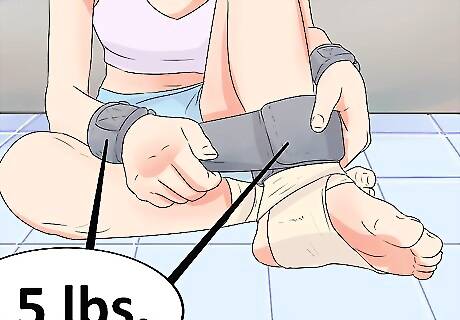
Wear weights. Wear three- to five-pound wrist- and ankle-weights during sparring sessions, as well as during other training. Grow accustomed to having to work harder to accomplish strikes, blocks, and footwork effectively. Develop the necessary speed and power with this extra weight in order to increase your endurance during live matches, when your hands and feet will be that much lighter without the weights. This will also make it easier for you to keep your hands up to block strikes despite growing tired over the course of particularly long or brutal matches. Be aware that consistent use of ankle and leg weights have been linked to injuries due to the extra strain they place on your joints. Such injuries are not universal among all users, but play it safe anyway. Avoid using them all the time and discontinue immediately if you begin to feel pain in nearby joints, tendons, and ligaments. You can also use a weighted vest to strengthen your legs when you're doing exercises like sprints and lunges.
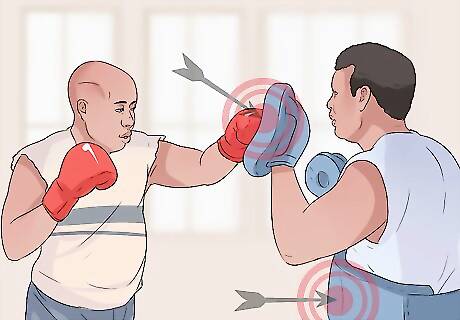
Use focus pads. Take time out from sparring to practice your offense. Ask a partner to hold up pads for you to punch and kick. Use this opportunity to perfect your strikes without having to worry about being struck in return. Focus on delivering your strikes with optimum force and minimal effort so that doing so comes more naturally to you in the midst of a match.
Strengthening Your Defence

Keep your head mobile. Hold your hands up to block strikes as instructed, but do not rely on this alone to keep your head protected in a match. In addition to raising your hands and arms for cover, make your head a moving target so that your opponent’s strikes are less likely to connect. Stand in front of a mirror. Imagine that you have a marker fixed to the top of your head. Now practice moving your head as though you were writing a specific letter of the alphabet on the ceiling, over and over again. Stick to letters that are simple in design, like T, V, C, S, and L. Be sure to practice their mirror image, as well. Don’t bother with more intricately designed letters like A, B, and R, or any other letter that continues to feel awkward in practice, since these head movements have little practicality in a match. Once each movement feels natural after practicing them alone in front of a mirror, incorporate them one by one into sparring sessions to learn which works best as an evasive maneuver against certain strikes. Try using a slip ball to help you work on your reactions and head movement.

Volunteer to hold pads. When you pair off with a partner to practice strikes, don’t cheat yourself by placing too much emphasis on your turn as striker. Use the role as strike to improve your defense. Since you don’t have to worry about getting hit anywhere other than your pads, seize this opportunity to strengthen skills beyond the offense: Take the time to analyze your partner’s stances and techniques. Develop your skill at identifying their weaknesses and habits in the moment, so that you will be quicker to recognize the same weaknesses in other opponents during live matches. Since you have fewer things to do with your hands, use this opportunity to concentrate your footwork. Learn how to dictate the fight with your feet alone. Focus on how you can alternate your speed, footing, and direction to disrupt your partner’s tempo and back them up in directions they don’t want to go.
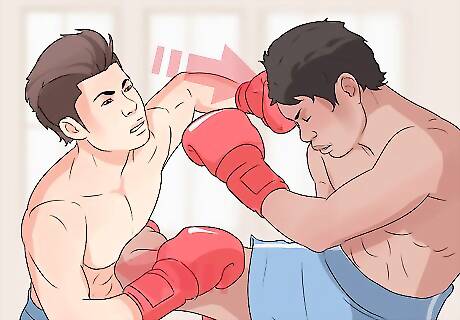
Grow accustomed to being struck. Getting hit can literally be a blow both physically and mentally. Face the reality that this will happen. Don’t define “the perfect fighter” as someone who never gets hit. Instead, aim to be the perfect fighter who bounces back from blows instantly. Embrace every strike that sneaks by your defenses in training as an opportunity to grow that much more acquainted with the sensation of being struck. When it is your turn to hold pads when practicing strikes with a partner, focus on your blocks and shields to further normalize the feel of receiving blows so that they are less of a distraction in live matches. Use medicine balls to acquaint your core with being struck. Ask a partner to stand beside you while you lay on the floor and do crunches, sit-ups, ab pikes, or similar exercises in which your back is on the ground in between each rep. Before you begin, agree to the amount of force your partner will use. Then, in between each rep, when your back is flat on the ground, let them drop or even hurl the medicine ball straight at your abs.
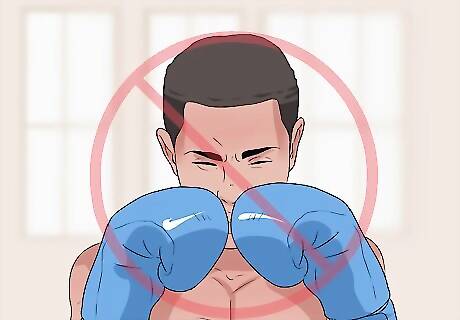
Keep your eyes open. The closer your opponent is to you, the more likely either one of you can deliver a strike in the blink of an eye. So don’t blink! Avoid missing an incoming strike or an opening on their part that you can take advantage of. Keep your eyes peeled as long as possible when you are in close, and blink rapidly to make up for it when you are spread well apart from each other. Keeping your eyes open for as long as you can is a technique that you can easily practice both in and out of the ring.
Improving Your Footwork Outside the Ring
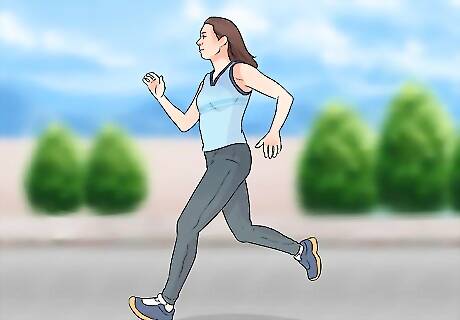
Jog. Build physical endurance that will carry over to matches within the ring. At the same time, grow accustomed to having to move your feet a lot during matches. To avoid overexerting yourself and risking injury, start off with daily jogs at both a pace and a duration that you can manage easily, so that you are able to converse with a partner without becoming too winded. If needed, alternate between jogging and walking in the beginning if your endurance is low at first. Set off at a jogging pace for one minute, then fall back to walking for four minutes. Repeat three times for a total of 20 minutes. As this grows more comfortable, increase the time spent jogging and reduce that spent walking period by one minute each from run to run until you are able to comfortably jog for 20 minutes without stopping. From there, add additional increments of five or ten minutes to your runs as they become more manageable.
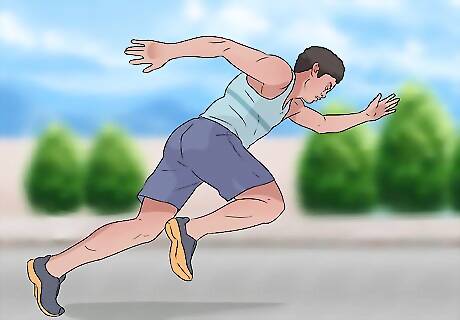
Run sprints. Once you are able to jog for a fair amount of distance, work on increasing your speed. Improve your ability to burst into motion at maximum speed so you can move around the ring quickly. Hit the track and run reps on the 100-meter straightaway. Again, start small in order to avoid overexerting and hurting yourself. Keep to only a handful of reps at first. Start off with a less-than-full sprint that you can maintain from start to finish of each rep, so that your last rep matches the same speed as your first. As each workout becomes easier, increase your speed to a full sprint. Then add a rep or two to each workout. Be sure to go for a short jog first to warm your legs up and reduce the chance of injury. Alternating long-distance running and sprints will help you improve your stamina and recovery while also preparing you for the chaos of a boxing match.
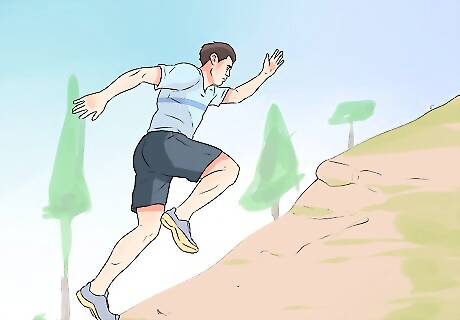
Charge hills. After warming up with a brief jog, run intervals up the slope of a low, steep incline, or, if all of the hills in your area are all incredibly high, mark a finish line along the slope that you can reach in about eight to twelve seconds. Sprint up the hill with short strides. Walk or jog back down, and then repeat. Develop the ability to spring off your toes with this workout, which maximizes the most amount of muscles in your legs. As with all interval training, take baby steps at first to familiarize yourself with the physical demands of this workout. Ease off the pace in the beginning. Aim to run a consistent speed in each rep throughout the workout. Once you can manage to run that pace from start to finish, increase your speed with the next workout.
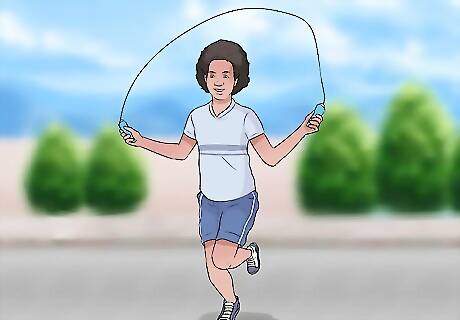
Jump-rope. Improve your balance while you exercise your feet and legs with a variety of jump-rope workouts. Jump with both feet for three minutes at a slow pace until this becomes nearly effortless. Then alternate between fast and slow with 30-second intervals of each speed, for a total of three minutes. In other rounds, stick to jumping on just one foot for a total of ten steps, then switch to the other, until your three minutes are up. Avoid sticking to just one pace or style from workout to workout, so you can better adapt to quick changes in your opponent’s speed in the ring.
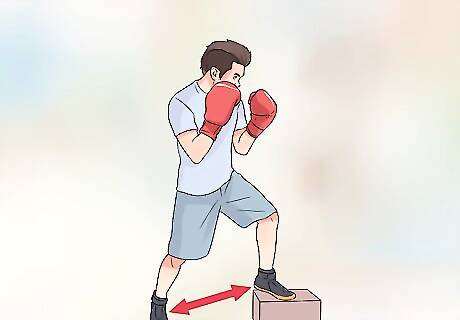
Do box steps. Find a step, sturdy box, or other elevated surface that will support your weight. Use one that is about a foot high, or roughly shin-level when you stand next to it. Do step workouts at sprint-speed. Do “one” steps (returning each foot to ground-level before stepping up with the other foot), “double” steps (bringing one foot up, then the other, before returning each to ground level), or a combination of the two, to increase speed and force. Consistency is key, so start off with moderate intervals of 30 seconds each until you are able to perform each at an even speed with no missteps. Then gradually increase your reps by 10 or 15 seconds in future workouts.
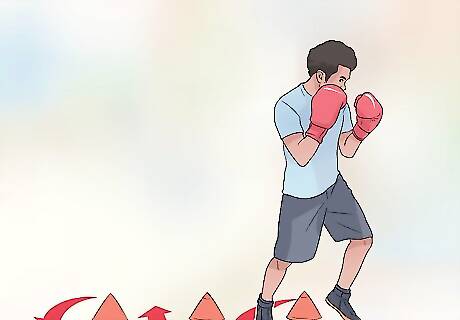
Practice backing up. Set up a minimum of four traffic cones (or other suitable obstacles) in a straight line. Place them evenly, with enough room between each for you to weave between them. Stand at the head of the line with your back to the cones. Then, keeping your heels off the ground, jog backwards and weave around each cone. At the end of the line, about-face by pivoting on the ball of one foot, and then repeat. Increase your confidence in retreating from your opponents without tripping over your own feet or having to look behind you. Whatever objects you choose in lieu of traffic cones, make sure they are relatively soft or otherwise unlikely to cause injury should you make a few missteps in the beginning.




















Comments
0 comment